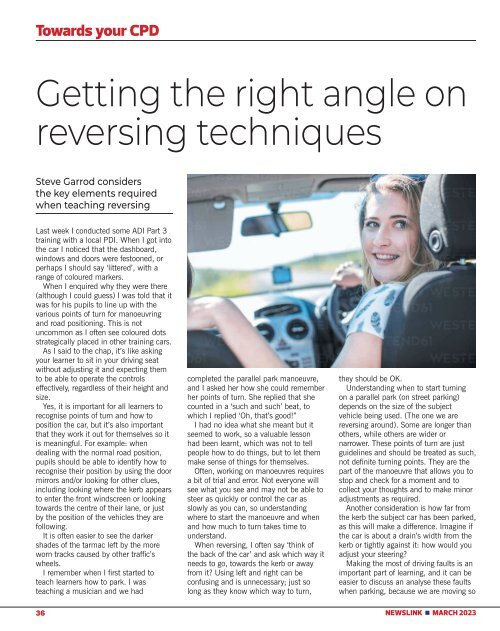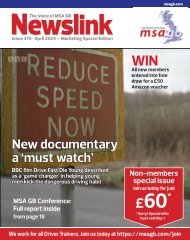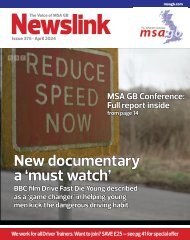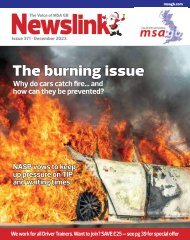Newslink March
Motor Schools Association of Great Britain; driver training and testing
Motor Schools Association of Great Britain; driver training and testing
Create successful ePaper yourself
Turn your PDF publications into a flip-book with our unique Google optimized e-Paper software.
Towards your CPD<br />
Getting the right angle on<br />
reversing techniques<br />
Steve Garrod considers<br />
the key elements required<br />
when teaching reversing<br />
Last week I conducted some ADI Part 3<br />
training with a local PDI. When I got into<br />
the car I noticed that the dashboard,<br />
windows and doors were festooned, or<br />
perhaps I should say ‘littered’, with a<br />
range of coloured markers.<br />
When I enquired why they were there<br />
(although I could guess) I was told that it<br />
was for his pupils to line up with the<br />
various points of turn for manoeuvring<br />
and road positioning. This is not<br />
uncommon as I often see coloured dots<br />
strategically placed in other training cars.<br />
As I said to the chap, it’s like asking<br />
your learner to sit in your driving seat<br />
without adjusting it and expecting them<br />
to be able to operate the controls<br />
effectively, regardless of their height and<br />
size.<br />
Yes, it is important for all learners to<br />
recognise points of turn and how to<br />
position the car, but it’s also important<br />
that they work it out for themselves so it<br />
is meaningful. For example: when<br />
dealing with the normal road position,<br />
pupils should be able to identify how to<br />
recognise their position by using the door<br />
mirrors and/or looking for other clues,<br />
including looking where the kerb appears<br />
to enter the front windscreen or looking<br />
towards the centre of their lane, or just<br />
by the position of the vehicles they are<br />
following.<br />
It is often easier to see the darker<br />
shades of the tarmac left by the more<br />
worn tracks caused by other traffic’s<br />
wheels.<br />
I remember when I first started to<br />
teach learners how to park. I was<br />
teaching a musician and we had<br />
completed the parallel park manoeuvre,<br />
and I asked her how she could remember<br />
her points of turn. She replied that she<br />
counted in a ‘such and such’ beat, to<br />
which I replied ‘Oh, that’s good!”<br />
I had no idea what she meant but it<br />
seemed to work, so a valuable lesson<br />
had been learnt, which was not to tell<br />
people how to do things, but to let them<br />
make sense of things for themselves.<br />
Often, working on manoeuvres requires<br />
a bit of trial and error. Not everyone will<br />
see what you see and may not be able to<br />
steer as quickly or control the car as<br />
slowly as you can, so understanding<br />
where to start the manoeuvre and when<br />
and how much to turn takes time to<br />
understand.<br />
When reversing, I often say ‘think of<br />
the back of the car’ and ask which way it<br />
needs to go, towards the kerb or away<br />
from it? Using left and right can be<br />
confusing and is unnecessary; just so<br />
long as they know which way to turn,<br />
they should be OK.<br />
Understanding when to start turning<br />
on a parallel park (on street parking)<br />
depends on the size of the subject<br />
vehicle being used. (The one we are<br />
reversing around). Some are longer than<br />
others, while others are wider or<br />
narrower. These points of turn are just<br />
guidelines and should be treated as such,<br />
not definite turning points. They are the<br />
part of the manoeuvre that allows you to<br />
stop and check for a moment and to<br />
collect your thoughts and to make minor<br />
adjustments as required.<br />
Another consideration is how far from<br />
the kerb the subject car has been parked,<br />
as this will make a difference. Imagine if<br />
the car is about a drain’s width from the<br />
kerb or tightly against it: how would you<br />
adjust your steering?<br />
Making the most of driving faults is an<br />
important part of learning, and it can be<br />
easier to discuss an analyse these faults<br />
when parking, because we are moving so<br />
36 NEWSLINK n MARCH 2023

















